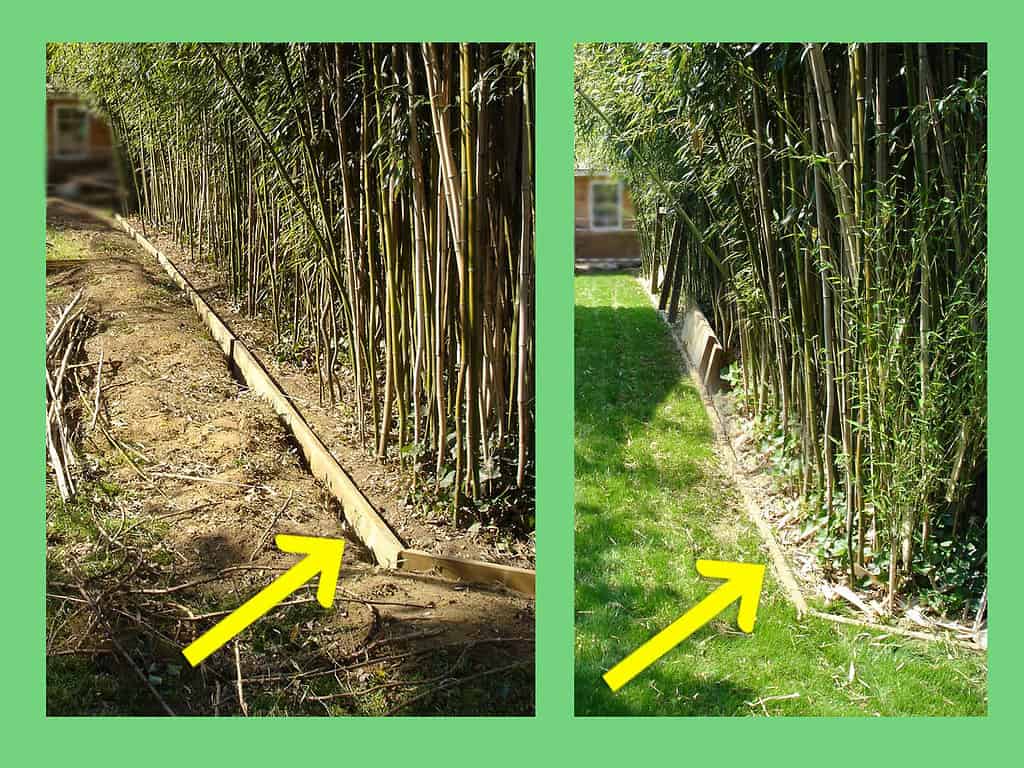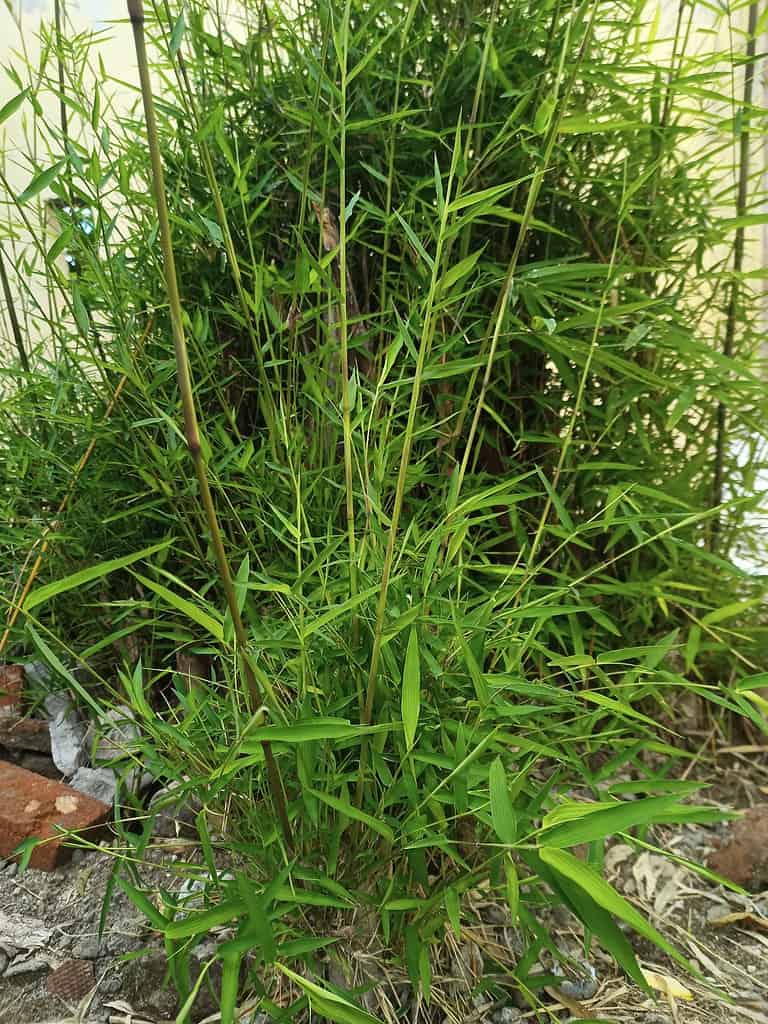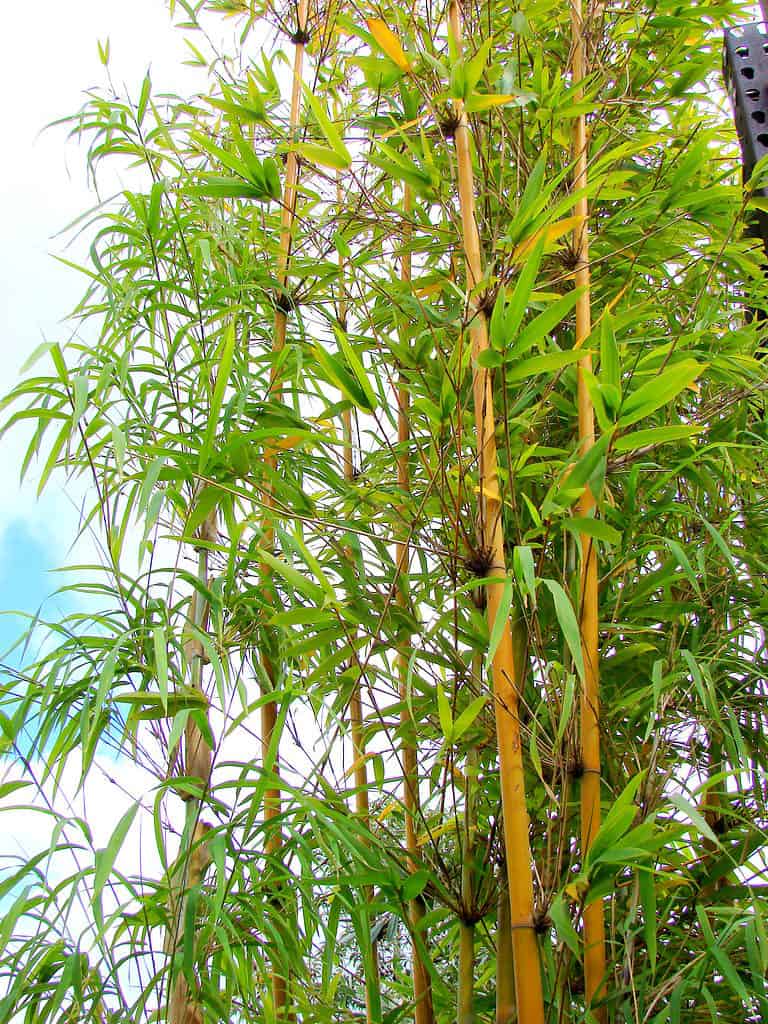Bamboo is often mistaken for a tree due to its height. Some varieties can grow upwards of 100 feet tall. But, even though some varieties can reach such lofty heights, bamboo is not a tree. It is a member of the true grass family Poaceae. The uses for bamboo are far more than can be listed here. Some of its applications include fencing, construction scaffolding, furniture, and flooring. It also has culinary uses, and not just for pandas! There are a lot of recipes that incorporate bamboo as a primary ingredient. In addition to all of these uses, bamboo is grown as a landscape ornamental as well as a natural privacy screen. But which bamboo is right for your Oklahoma landscape? It can become rather complicated, but feeling bamboo-zled is unnecessary (sorry). Let’s clear things up!
Running vs. Clumping Bamboo
There are over 1,400 species of bamboo, which certainly seems to complicate things for gardeners and landscapers. But all those species are separated into just two categories, making things much simpler. Every bamboo species is either running or clumping bamboo. Knowing the difference is vital for bamboo growers.
Running Bamboo
Running bamboo (often known simply as “runners”) is the fastest-growing plant in the world. On average, runners can spread three to five feet per year on average, but some running bamboo species can spread as much as 10-15 feet per year. Some extreme varieties of running bamboo can add 35 inches of vertical growth in just 24 hours!
This exceptionally rapid growth can easily lead to problems. Countless well-intentioned growers have been overwhelmed by the prolific spread of running bamboo. The growth is so fast and relentless that runners often leave their intended boundaries, encroaching on a neighbor’s property or other areas where these bamboos are unwelcome. And once a runner is “on the run,” it is very difficult to stop. The rhizomes (the fast-spreading horizontal root systems) must be completely dug up, which is backbreaking work. Or the bamboo must be treated with chemicals, which is also labor-intensive and can be dangerous.

Golden bamboo (Phyllostachys aurea) is a popular running bamboo but is considered invasive in several states.
©iStock.com/Wirestock
Clumping Bamboo
On the other hand, clumping bamboo (known as clumpers) is much more slow growing. These bamboos have a short root structure that expands, at most, a few inches each year.
Only around one-third of bamboo species are clumpers, so that can significantly narrow down your choices. This is welcome news for any grower who is feeling a bit overwhelmed by all the different bamboo types available today.
The extreme spread of running bamboo has led some states and localities to declare certain species invasive. Clumpers, on the other hand, are much easier to control. If growers insist on growing running bamboo, a barrier must be installed before the bamboo is planted. DIY barriers are often made of pressure-treated wood. Commercial barriers made of polyethylene plastic are also available.
The easier choice by far is to plant clumping bamboo. Clumpers can still try to outgrow their boundaries, but the growth is slow, and it is far easier to rein them in.

In-ground barriers are critical to contain running bamboo.
Hardiness Zones
Along with deciding between running or clumping bamboos, growers also need to know their USDA plant hardiness zone. Planting a bamboo that is ill-suited to your hardiness zone simply invites frustration and failure.
Oklahoma’s coldest zone is Zone 6a, but this is relegated to a tiny sliver of the state in northwest Cimarron County. The warmest Oklahoma zone is Zone 8a, but it too is limited to a super small section of the Sooner State. Small portions of Choctaw and McCurtain counties in southeast Oklahoma are the only locations found within this zone.
The vast majority of Oklahomans reside in Zones 6b-7b. This further simplifies the bamboo choices for Oklahoma landscapers. Many bamboo species will not grow well, or at all, in these zones, but there are some that certainly will. This is not an exhaustive list, but here are a few of the best bamboo choices for Sooner landscapers and gardeners.
Fargesia Bamboos
The many cultivars of Fargesia bamboo are wonderful options for Oklahoma growers. These clumping bamboos are non-invasive and cold-hardy. There is a Fargesia variety for every zone in the Sooner State.
Fargesia bamboos are native to the mountains of Southwestern China. They are an important food source for giant panda bears. This bamboo is also found in Cambodia, Laos, Thailand, and Vietnam.
Fargesia bamboos generally feature culms of light green with darker green leaves. These clumping bamboos grow upright, but they have a much shorter maximum height than many other bamboos.
Fargesia Scabrida
Fargesia scabrida bamboos are exceptionally cold-hardy. They are recommended for growing in Zones 6-9, meaning every Oklahoma bamboo lover should strongly consider this variety.
This bamboo is relatively new to the U.S. market. It was not widely available until the late 1990s-early 2000s. This bamboo was discovered in Sichuan, China growing in rainforests over 8,800 feet above sea level.
Fargesia scabrida bamboo features lovely colors that change through the growing season. New culms are blue and purple with orange sheathing. The culms change to olive green as they mature.
It is fairly fast-growing, adding one to three feet of height per year. Like most Fargesia bamboos, it is a small to mid-sized bamboo, topping out at 12-14 feet tall.

bamboo is cold-hardy to Zone 6.
©Maurice Lesca/Shutterstock.com
Fargesia Robusta
This variety is recommended for Zones 7-9, making it a great choice for many Oklahoma growers. Oklahomans in the northeast and northwest corners of the state should skip this bamboo, but it can thrive in the remainder of the state.
There are a number of Fargesia Robusta cultivars, most of which will grow 12-15 feet tall. The ‘Campell’ cultivar (pictured above) has a tighter clumping habit and smaller leaves than other cultivars such as the Pingwy, Wolong, and Wenchuan.

‘Campbell’ is a great ornamental for most Oklahoma growers.
©Tity Wijayanti/Shutterstock.com
Weaver’s Bamboo (Bambusa textilis)
Weaver’s bamboo is another variety that is rated for Zones 7-9. Most Oklahomans can grow this clumping bamboo with great success.
Per its name, this bamboo variety is very popular in basket and furniture weaving. It is also widely grown as an ornamental and privacy screen bamboo.
Weaver’s bamboo is deer resistant, which is music to the ears of Oklahoma growers. The state is home to three-quarters of a million deer, after all.
There are multiple varieties of weaver’s bamboo that grow to varying heights. The most common is slender weaver’s bamboo (Bambusa textilis var. gracilis), which grows roughly 25 feet tall. That is adequate to provide a privacy screen for a standard two-story house.
If you want something shorter, the dwarf variety (Bambusa textilis ‘Dwarf’) tops out around 18 feet tall. Or, if you’re looking for a super tall bamboo, the giant weaver’s bamboo (Bambusa textilis ‘Kanapaha’) grows to heights over 50 feet.

Weaver’s bamboo makes a great privacy screen.
©Forest & Kim Starr, CC BY 3.0, via Wikimedia Commons – Original / License
Other Bamboos
The three clumping bamboos discussed above are not the only bamboos that can be grown successfully in Oklahoma. It is not easy to find clumping bamboos that can grow down to Zone 6, though. There are many more runners than clumpers that can tolerate the cold.
Some cold-hardy runners to consider include:
- Red Margin Bamboo (Phyllostachys Rubromarginata ‘Red Margin’) – Zones 5-11
- Nuda Bamboo (Phyllostachys Nuda) – Zones 6-9
- Yellow Groove Bamboo (Phyllostachys Aureosulcata ‘Yellow Groove’) – Zones 5-11
- Ruscus Bamboo (Shibataea Kumasaca ‘Ruscus Bamboo’) – Zones 6-10
If you are thinking about planting a running bamboo, make sure it is not considered invasive in your locality. As mentioned earlier, install a barrier before planting. But even with a barrier, there will always be a risk of the bamboo growing out of bounds. It requires consistent attention to keep runners hemmed in.
Thank you for reading! Have some feedback for us? Contact the AZ Animals editorial team.








